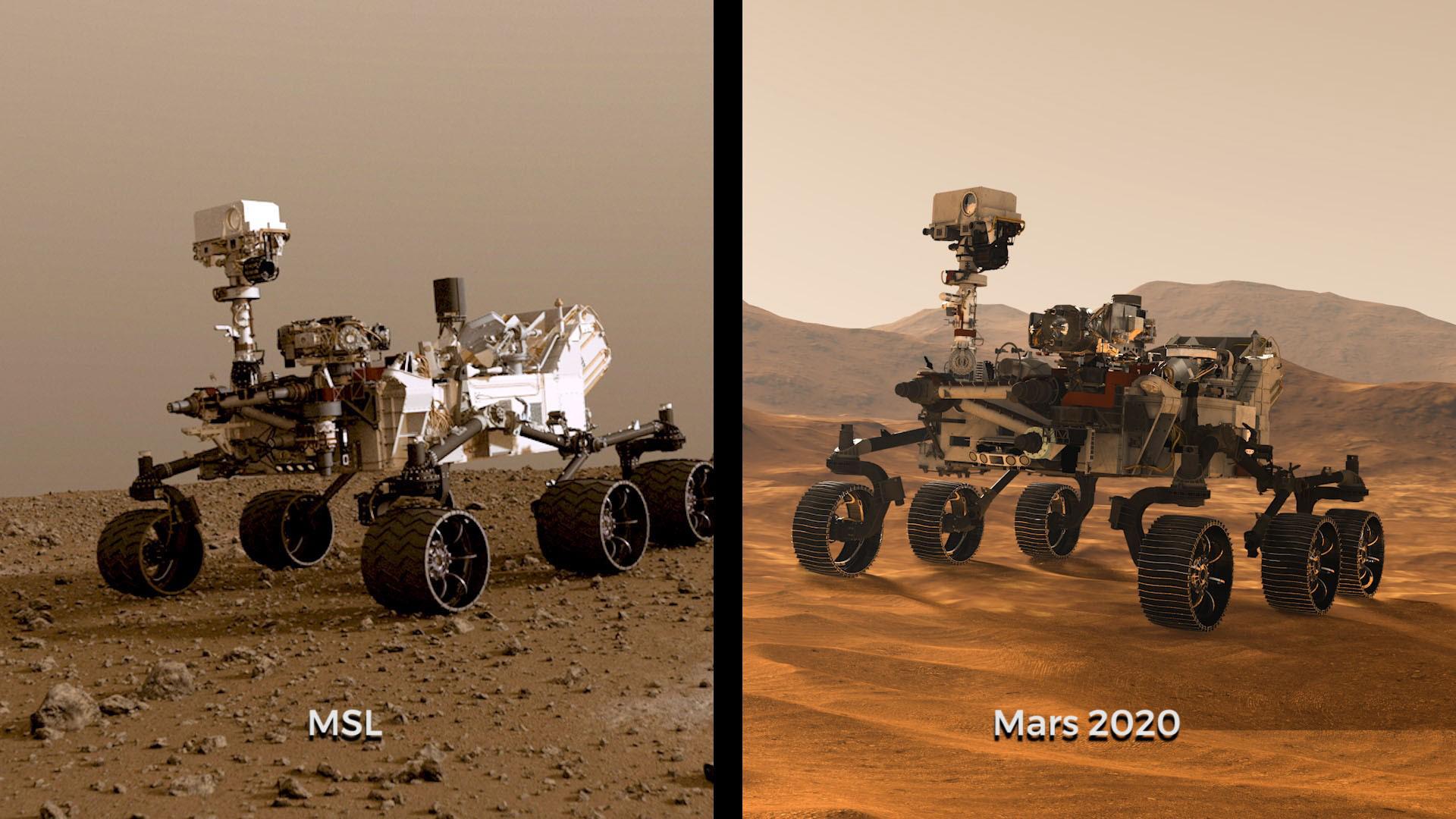NASA's New Mars 2020 Car May Look Like the Curiosity Rover, But It's No Twin

NASA plans to launch a rover to Mars this July to hunt for signs of ancient Red Planet life.
The new Mars 2020 rover's body is similar to that of the older Curiosity rover, which landed in 2012. But the two machines are quite different in important ways.
Curiosity's mission centers on assessing the past habitability of its landing site, the 96-mile-wide (154 kilometers) Gale Crater. The rover quickly determined that Gale harbored a potentially habitable lake-and-stream system in the ancient past, and Curiosity is now fleshing out that long-gone environment as it climbs the foothills of Mount Sharp, which rises 3.4 miles (5.5 km) into the sky from Gale's center.
Related: NASA's Mars Rover 2020 Mission in Pictures
Mars 2020 will characterize the habitability of its landing site, Jezero Crater, after touching down in February 2021. But the new rover will also hunt for ancient biosignatures — signs of past life that could be lurking in rock or soil samples. And Mars 2020 will cache the most promising samples for return to Earth by a future mission.
The mass and dimensions of the rovers differ as well. Mars 2020 is about 5 inches (13 centimeters) longer and 280 lbs. (127 kilograms) heavier than Curiosity. That's because Mars 2020 will carry a different set of tools, officials with NASA's Jet Propulsion Laboratory (JPL) explained in a recent statement.
The two robots' arms have the same reach (7 feet, or 2.2 meters). But Mars 2020 has bigger instruments and a larger drill to do "coring."
Breaking space news, the latest updates on rocket launches, skywatching events and more!
"The drill will cut intact rock cores, rather than pulverizing them, and they'll be placed in sample tubes via a complex storage system," JPL officials said in the statement.
Curiosity has 17 cameras, including both color and black-and-white shooters. Mars 2020, by comparison, will carry 23, and most of them will take color photos. In addition, Mars 2020's Mastcam-Z will improve upon Curiosity's Mast Camera with zoom and high-definition video.
The newer rover, unlike its predecessor, will also carry two microphones to listen to the sounds of landing on Mars, as well as the Red Planet wind and the zaps coming from Mars 2020's onboard laser-equipped instrument.
Mars 2020 also will improve upon Curiosity's aluminum wheels, which have been damaged by sharp rocks. NASA successfully modified its driving plan for Curiosity to see it through its time on the Red Planet. But such troubleshooting may not be necessary for Mars 2020, whose wheels are bigger and thicker, and sport more treads, or "grousers."
"Extensive testing in JPL's Mars Yard has shown these treads better withstand the pressure from sharp rocks but work just as well on sand," JPL officials said.
Mars 2020 will also take advantage of advances in computing for "self-driving smarts," figuring out its path on Mars autonomously up to five times faster than Curiosity can. Mars 2020 team members hope this upgraded brain will reduce the amount of planning time needed for navigation, allowing the new rover to cover more ground and accomplish more tasks.
With the self-driving technique, daily operations could take 5 hours, compared with 7 for Curiosity, JPL officials stated. (Curiosity used to require 19 hours of analysis, but improved operations and newer autonavigation on Curiosity have reduced that time considerably in seven years.)
A final major difference is in the landing. Like Curiosity, Mars 2020 will endure "seven minutes of terror" that wraps up with a rocket-powered sky crane lowering the robot to the Martian surface on cables. But the new rover features "terrain relative navigation," an advanced system that will allow Mars 2020 to land much more precisely than its predecessor.
- Mars 2020: The Red Planet's Next Rover
- Life on Mars: Exploration & Evidence
- Photos: Ancient Mars Lake Could Have Supported Life
Follow Elizabeth Howell on Twitter @howellspace. Follow us on Twitter @Spacedotcom and on Facebook.


Elizabeth Howell (she/her), Ph.D., was a staff writer in the spaceflight channel between 2022 and 2024 specializing in Canadian space news. She was contributing writer for Space.com for 10 years from 2012 to 2024. Elizabeth's reporting includes multiple exclusives with the White House, leading world coverage about a lost-and-found space tomato on the International Space Station, witnessing five human spaceflight launches on two continents, flying parabolic, working inside a spacesuit, and participating in a simulated Mars mission. Her latest book, "Why Am I Taller?" (ECW Press, 2022) is co-written with astronaut Dave Williams.

